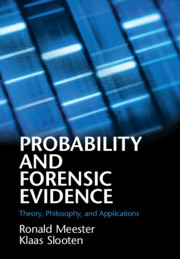Crossref Citations
This Book has been
cited by the following publications. This list is generated based on data provided by Crossref.
Kruijver, Maarten
Kelly, Hannah
Bright, Jo-Anne
and
Buckleton, John
2022.
Evaluating DNA Mixtures with Contributors from Different Populations Using Probabilistic Genotyping.
Genes,
Vol. 14,
Issue. 1,
p.
40.
Noe, Paul-Gauthier
Nautsch, Andreas
Matrouf, Driss
Bousquet, Pierre-Michel
and
Bonastre, Jean-Francois
2022.
A Bridge between Features and Evidence for Binary Attribute-Driven Perfect Privacy.
p.
3094.
Cereda, Giulia
Corradi, Fabio
and
Viscardi, Cecilia
2023.
Learning the two parameters of the Poisson–Dirichlet distribution with a forensic application.
Scandinavian Journal of Statistics,
Vol. 50,
Issue. 1,
p.
120.
van Leeuwen, Ludi
Verheij, Bart
Verbrugge, Rineke
and
Renooij, Silja
2023.
Using Agent-Based Simulations to Evaluate Bayesian Networks for Criminal Scenarios.
p.
323.
Dahlman, Christian
and
Nordgaard, Anders
2023.
Information economics in the criminal standard of proof.
Law, Probability and Risk,
Vol. 21,
Issue. 3-4,
p.
137.
McCarthy-Allen, M.
Bleka, Ø.
Ypma, R.
Gill, P.
and
Benschop, C.
2024.
‘Low’ LRs obtained from DNA mixtures: On calibration and discrimination performance of probabilistic genotyping software.
Forensic Science International: Genetics,
Vol. 73,
Issue. ,
p.
103099.
Kalafut, Tim
Curran, James M.
Coble, Michael D.
and
Buckleton, John
2024.
Commentary on: Thompson WC. Uncertainty in probabilistic genotyping of low template DNA: a case study comparing STRmix™ and TrueAllele™. J Forensic Sci. 2023;68 (3):1049–63. doi: 10.1111/1556‐4029.15225.
Journal of Forensic Sciences,
Vol. 69,
Issue. 1,
p.
371.
Buckleton, John
Susik, Mateusz
Curran, James M.
Cheng, Kevin
Taylor, Duncan
Bright, Jo‐Anne
Kelly, Hannah
and
Wivell, Richard
2024.
A diagnosis of the primary difference betweenEuroForMixandSTRmix™.
Journal of Forensic Sciences,
Vol. 69,
Issue. 1,
p.
40.
Meester, Ronald
and
Stevens, Lonneke
2024.
Bayesian reasoning and the prior in court: not legally normative but unavoidable.
Law, Probability and Risk,
Vol. 23,
Issue. 1,



